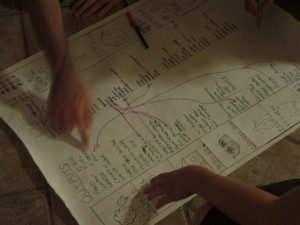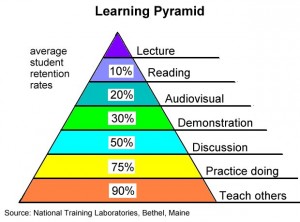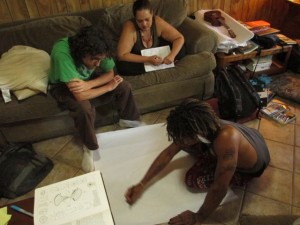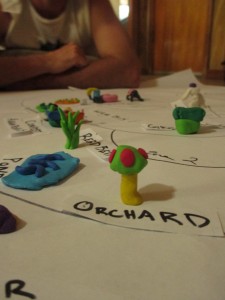Permaculture is such a hugely broad and challenging subject to teach. But it doesn’t have to be hard work. We can make permaculture education fun and interactive!
How many of us have ever felt challenged by attempting to sum up permaculture into a 30 second “elevator speech”? What about a thirty minute talk? One hour? It seems like the longer you have to talk about permaculture the easier it gets. Perhaps that is because permaculture covers such a wide verity of disciplines and subjects that the elevator speech just can’t do it justice. But, try keeping that up for a full 72 hour PDC and, it doesn’t matter how many subjects you are able to cover, how knowledgeable you are, or how much depth you are able to go into on any particular topic, if all you do is talk… you’ll have lost the audience, and with it the opportunity to inspire, before you’ve even begun to get to the good bits.
 Teaching permaculture should never be a chore for either the student or the teacher. And believe me if you have never tried, talking for 6 – 8 hours a day about anything is just plain hard work. I recommend taking a break from all that hard work and exercise a little permaculture design on your permaculture design course.
Teaching permaculture should never be a chore for either the student or the teacher. And believe me if you have never tried, talking for 6 – 8 hours a day about anything is just plain hard work. I recommend taking a break from all that hard work and exercise a little permaculture design on your permaculture design course.
The Design Process
As with any good design process, take some time to think about your goals. What is your goal for teaching permaculture? I can’t answer that question for you but I can encourage you to take the time to really examine it. At it’s root, it’s probably similar to the reason you’ve been refining that elevator speech.
Only when we’ve spent significant quality time reflecting on the “why”, can we begin to peer into the “what”. Analyze and assess what it is you want to teach and what resources you have to help attain your goals. As with any design process, the answers to this question will often feedback into our goals. We may even want to revisit and refine our goals several times before proceeding beyond this point.
Once we have built solid foundation by articulating our goals and assessing our resources and limiting factors, we can begin frame out our design. What does the perfect course look like? And how do you design a course that can utilize the resources you have available, make the best out of the limitations you have to work within and, most importantly, achieves your goals (and, maybe even more importantly, the goals of those who might participate)?
Crawl Before You Walk
Walk Before You Run
Does this sound like a challenge? Maybe, if you have been through the design process several times already since you took your PDC, this seems pretty straightforward. But, more likely, if you have little experience in front of groups or teaching in general, talking about it in relation to a simple design process does nothing to quell your anxiety. Honestly, it is better to recognize the scope of what you are about to engage in over discovering too late that you’ve jumped in over your head without a proper life vest. But don’t give up…
Teaching a Permaculture Design Certificate course is a major undertaking. Slow & small solutions is the name of the game. As a first step, you might really work to nail that elevator speech. If you feel like you could talk for days about permaculture, and find yourself doing so, maybe it’s time to jump ahead to working your way into some public speaking engagements. Test your knowledge of permaculture as well as your comfort in front of crowds before really digging in. If that goes well, engage your local teachers and see if they have any opportunities where you could take on one or two of the session in their course.
Keep pushing yourself outside of your comfort zone. The best way to learn material is to put yourself in a position where others are expecting to learn something from you. Those expectations can do a lot for your motivation to really refine and round out your knowledge. If the opportunity is available to you, I encourage you to take a teacher training course or, even better, an internship position with an education center. These are great ways to sort out your curriculum, gain experience in what it takes to run a course and take your turn standing in front of a room full of attentive students.
When you are finally feeling confidante enough to take on your own classroom, test yourself further by starting with a permaculture introduction course or some hands-on workshops. Remember… the PDC is, at a minimum, a 72 hour intensive blast! You want to make sure you are really well grounded and comfortable on your feet before running the marathon.
Teach to learn
According to the National Training Laboratories, the best and most effective way to learn something is to teach it.
 That means, to be the most effective teacher you can be, you must find creative ways to get your students teaching. But you don’t have to wait for the student to start up a course of their own to get them teaching, you have a perfect opportunity to facilitate that process right from within the classroom environment you already share.
That means, to be the most effective teacher you can be, you must find creative ways to get your students teaching. But you don’t have to wait for the student to start up a course of their own to get them teaching, you have a perfect opportunity to facilitate that process right from within the classroom environment you already share.
Cultivate a learning environment that is engaging, interactive and fun through the use of activities and scenarios that give the students the confidence to teach as well as the permission to make mistakes. Put the responsibility of education into the hands of the students themselves and connect what they already know to the material you are presenting. Make room for many groups activities that give students the opportunity to share their unique skills and knowledge about the various topics permaculture traverses.
To accomplish this, we’ll likely need to spend a little more time designing our lesson plans and preparing for the session. Just like permaculture design in the landscape, we are benefited from more observation, consideration and thoroughness of design before we begin to implement.
A Bag Full of Tricks
If this whole concept is new to you and you feel yourself struggling to move beyond the lecture format, much of what I’ve just said might sound great but isn’t all that helpful to you without examples of some activities that can take the place of those lectures. It’s easy enough to say that would should be teaching interactively… but how do we actually do it? What if you are one of those people who has depended on the lecture as your trusty standby method for getting material across in a classroom? How do you actually get the students to take up more of the teaching role within the classroom?
 I personally recommend collecting a bag or two full of tricks to help you think, plan and teach creatively. Fortunately there are some great resources out there to help us fill up our bags with interactive games and exciting and educational activities. Some of the resources I recommend:
I personally recommend collecting a bag or two full of tricks to help you think, plan and teach creatively. Fortunately there are some great resources out there to help us fill up our bags with interactive games and exciting and educational activities. Some of the resources I recommend:
Permaculture Teachers’ Guide – a collection of lesson plans from a wealth of experienced teachers, edited by Andrew Goldring
Earthuser’s Guide to Permaculture: Teacher’s Notes by Rosemary Morrow
Manual for Teaching Permaculture Creatively by Robin Clayfield and Skye
The Systems Thinking Playbook: Exercises to Stretch and Build Learning and Systems Thinking Capabilities by Linda Booth Sweeney and Dennis Meadows.
Adding these resources into your tool box is an excellent way to find creative solutions to challenging, lecture heavy subjects. When you are ready, I recommend assembling a curriculum that incorporates some of your favorite activities within the framework of the requisites Bill Mollison established in Permaculture: A Designers Manual.
Curriculum Design: Patterns to Details
My strategy for curriculum development is to work from patterns to detials. I start with a broad outline for the course I’m about to teach. Then I break this down into 90 minute sessions and create themes for each session. From here I design in breaks, meals and review session before proceeding to further break each 90 minute session down into anywhere from 3 to 5 smaller chunks ranging from 10 to 45 minutes. This helps me to design in introductions to material, interactive lessons, group work, presentations, etc…
 Working from the patterns into the details really helps to frame the big picture first and narrow down into individual lessons and activities later. This generates a sense of cohesiveness and flow to the course you are teaching and keeps students engaged. The overall flow of the course is perhaps far more important than any individual lesson (no matter how cool that lesson is going to be). Keeping that flow, however, can sometimes require you to be light on your feet and creatively adapt and respond to change.
Working from the patterns into the details really helps to frame the big picture first and narrow down into individual lessons and activities later. This generates a sense of cohesiveness and flow to the course you are teaching and keeps students engaged. The overall flow of the course is perhaps far more important than any individual lesson (no matter how cool that lesson is going to be). Keeping that flow, however, can sometimes require you to be light on your feet and creatively adapt and respond to change.
This is why I emphasis even more the value of having a bag of tricks at your disposal to help you respond to and improve group energy levels, and help capture those individuals who might have fallen through the cracks of previous lessons. Having a set of icebreakers, energizers, review activities and spontaneous group breakout sessions on hand and ready to adapt to various lessons you might be teaching is a major asset to your effectiveness in this work. I would encourage you, however, to try to avoid becoming too dependent on other’s lesson plans and instead, think and act creatively as situations change within the classroom. As your comfort level grows, don’t be afraid to experiment with new ideas whenever possible.
When The Course Designer Becomes The Recliner
Teaching permaculture does not have to be a chore. In fact, Permaculture education can be a very rewarding and exhilarating experience for everyone involved. By doing a bit of preparation and design work before your course starts you’ll discover that permaculture almost teaches itself. Or at least, you can cultivate an environment that encourages students to become teachers and teachers to become students. Your job is not to preach to the choir but to let the choir sing and help to bring out the harmonies within their individual voices.
Putting the power to teach within the hands of your students not only gives them a better chance at retaining the information it also creates a more interactive and fun environment that further facilitates learning and makes the knowledge more accessible while cultivating a sense of community. Best of all, teaching permaculture interactively allows you to simply set the stage, give the actors a little direction and observe and feedback the results. Even better, this is much less challenging than 90 minutes of lecturing four times a day for 2 weeks. If you haven’t had the pleasure of the experience yet… even a 90 minute session of lecturing can be exhausting.
Permaculture Design Course at Creation Flame from Chowgene Koay on Vimeo.
If you are new to teaching permaculture, I hope that this article will help you avoid many of the early challenges new teachers face. If you are a seasoned veteran of permaculture education, I hope that this article will help to encourage you to find a more permaculture approach to your teaching style by letting the connection and the relationships of the elements (students) in the system (classroom) do much of the work for you. In this way, the course designer can be come a course recliner.
